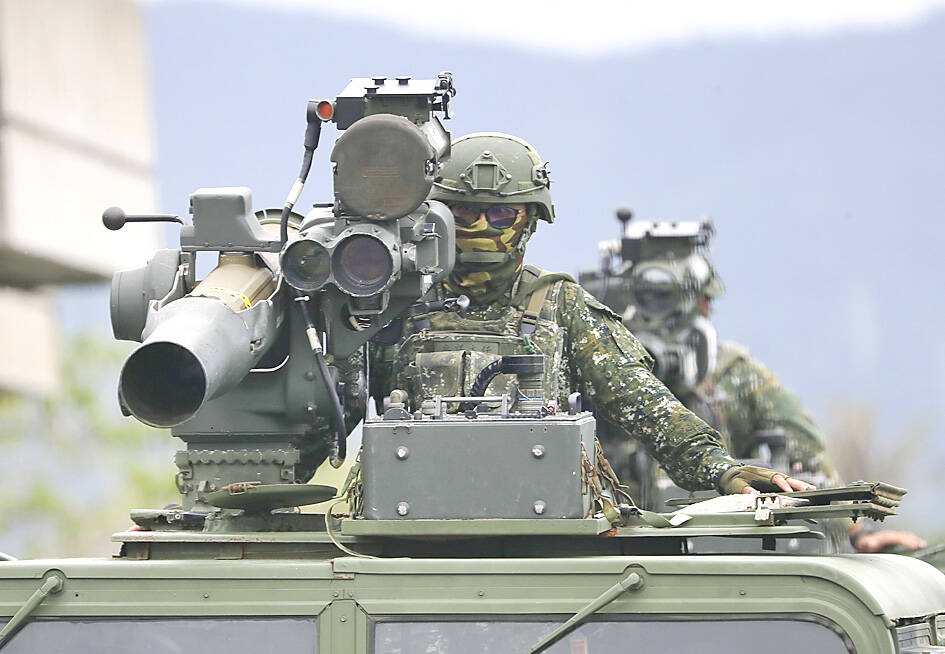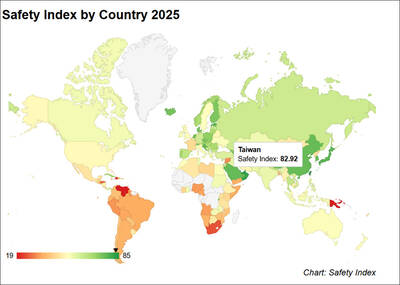Taiwan intends to invest a record-high NT$130.6 billion (US$4.1 billion) in military research and development, including a procurement of 1,779 drones, the Ministry of National Defense (MND) said in a report on the nation’s military force and policy plan for fiscal 2024.
The figure includes NT$111.4 billion in continued funding for previously approved projects, it said in the report submitted to the Legislative Yuan, adding that it would prioritize AIDC T-5 advanced jet trainers and indigenous defense submarine prototype and light frigates, which have been developed or are being developed domestically.
The ministry would allocate NT$19.2 billion to research and develop distributed command and control systems and a myriad of uncrewed aerial vehicles, as these systems have proven to be crucial in Russia’s war in Ukraine, the report said.

Photo: Chiang Ying-ying, AP
The three branches of the Taiwanese armed forces plan to build a fleet of 1,779 lightweight, off-the-shelves drones for reconnaissance, surveillance, observation and other applications, the report said.
The military would further invest in the domestic development of command, control and communication technology with an eye toward creating a self-sustaining defense industrial base, it said.
The nonclassified portion of the report did not make any references to developing trainer jets or plans for building additional indigenous defense submarines, although the ministry has allocated NT$3.9 billion to improve the prototype vessel.
Next year’s military maintenance and repair budget of NT$131 billion would be NT$2.6 billion lower than this year’s budget.
When asked, the ministry said this year’s budget was boosted by a NT$254 billion one-time special fund to obtain urgently needed ammunition and spare parts, which the military would not need next year.
Reduced spending on this area made it possible to increase the budget for training, it said.
Separately, the ministry on Thursday submitted this year’s report on Chinese military power to lawmakers, which said that Beijing is bolstering the Chinese People’s Liberation Army’s (PLA) capability to wage war in the Taiwan Strait.
The Chinese Communist Party is changing the composition of the Central Military Commission — equivalent to the chiefs of staff in other countries — to prioritize combat experience, technological expertise and knowledge about Taiwan, the report said.
This suggests that the PLA is trying to strengthen its capability to wage war against Taiwan and deny US access to the region, perhaps to fulfill Chinese President Xi Jinping’s (習近平) ambition to accelerate “unification” in his third presidential term, it said.
The PLA Ground Force is in the midst of establishing combined arms brigades in accordance with its doctrine of emphasizing mobile operations and three-dimensional attack and defense capabilities, the report said.
Meanwhile, the PLA Navy is focusing on developing its capability to stage an in-depth defense at sea between the first and second island chains and to engage a powerful military adversary by 2035, it said.
China’s third aircraft carrier, the Fujian, is undergoing fitting and testing, and awaiting production of a sufficient number of aircraft that it is to carry, the report said.
When all preparations are complete, the Fujian is expected to join the Liaoning and the Shandong to form an ocean-going carrier strike group with expeditionary capabilities, it added.
The PLA Air Force is pursuing its transformation into a strategic force capable of offensive and defensive operations, including conducting deep strikes and sustainment missions out to the second island chain, the report said.
China is likely to continue carrying out military activities targeting Taiwan, including utilizing gray zone tactics, cyberattacks, maritime drills and patrols, as well as mock amphibious assaults, it said.
Taiwan’s armed forces must establish clear priorities in acquiring key combat capabilities and integrate available resources efficiently to deter the PLA from invading the nation under the asymmetric conditions prevailing in the Taiwan Strait, the report said.
This means increased emphasis on mobility, quality, precision-strike capabilities and effective utilization of resources in the civilian sector to bolster national defense, it said.

AIR SUPPORT: The Ministry of National Defense thanked the US for the delivery, adding that it was an indicator of the White House’s commitment to the Taiwan Relations Act Deputy Minister of National Defense Po Horng-huei (柏鴻輝) and Representative to the US Alexander Yui on Friday attended a delivery ceremony for the first of Taiwan’s long-awaited 66 F-16C/D Block 70 jets at a Lockheed Martin Corp factory in Greenville, South Carolina. “We are so proud to be the global home of the F-16 and to support Taiwan’s air defense capabilities,” US Representative William Timmons wrote on X, alongside a photograph of Taiwanese and US officials at the event. The F-16C/D Block 70 jets Taiwan ordered have the same capabilities as aircraft that had been upgraded to F-16Vs. The batch of Lockheed Martin

GRIDLOCK: The National Fire Agency’s Special Search and Rescue team is on standby to travel to the countries to help out with the rescue effort A powerful earthquake rocked Myanmar and neighboring Thailand yesterday, killing at least three people in Bangkok and burying dozens when a high-rise building under construction collapsed. Footage shared on social media from Myanmar’s second-largest city showed widespread destruction, raising fears that many were trapped under the rubble or killed. The magnitude 7.7 earthquake, with an epicenter near Mandalay in Myanmar, struck at midday and was followed by a strong magnitude 6.4 aftershock. The extent of death, injury and destruction — especially in Myanmar, which is embroiled in a civil war and where information is tightly controlled at the best of times —

Taiwan was ranked the fourth-safest country in the world with a score of 82.9, trailing only Andorra, the United Arab Emirates and Qatar in Numbeo’s Safety Index by Country report. Taiwan’s score improved by 0.1 points compared with last year’s mid-year report, which had Taiwan fourth with a score of 82.8. However, both scores were lower than in last year’s first review, when Taiwan scored 83.3, and are a long way from when Taiwan was named the second-safest country in the world in 2021, scoring 84.8. Taiwan ranked higher than Singapore in ninth with a score of 77.4 and Japan in 10th with

SECURITY RISK: If there is a conflict between China and Taiwan, ‘there would likely be significant consequences to global economic and security interests,’ it said China remains the top military and cyber threat to the US and continues to make progress on capabilities to seize Taiwan, a report by US intelligence agencies said on Tuesday. The report provides an overview of the “collective insights” of top US intelligence agencies about the security threats to the US posed by foreign nations and criminal organizations. In its Annual Threat Assessment, the agencies divided threats facing the US into two broad categories, “nonstate transnational criminals and terrorists” and “major state actors,” with China, Russia, Iran and North Korea named. Of those countries, “China presents the most comprehensive and robust military threat